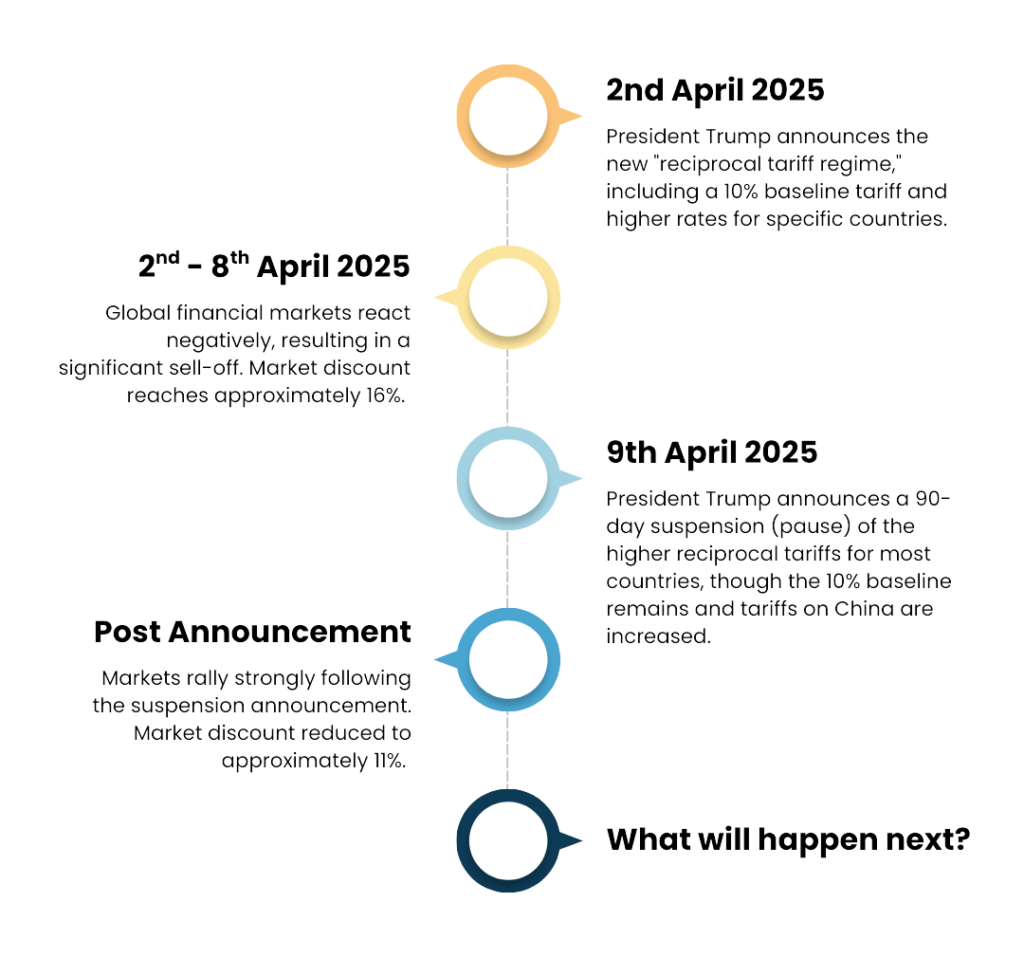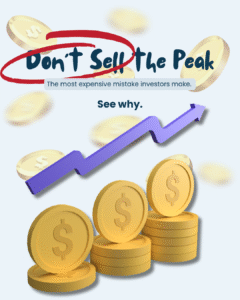The past week has felt like a rollercoaster for anyone watching the news or the markets. One minute, the U.S. government under President Trump announced sweeping new taxes, called tariffs, on goods coming into the country. The next, just hours after they started, many of those same tariffs were suddenly put on hold. If you’re feeling confused, you’re not alone. Let’s break down what happened and share our perspective at AutoWealth on what this might mean for investors.
What Just Happened? Tariffs On, Tariffs Off (Mostly)

Figure 1: A brief timeline of what is exactly happening during the Tariffs Turmoil
Think of tariffs as extra taxes slapped onto products imported from other countries. Early in April 2025, the Trump administration rolled out a big plan: a basic 10% tariff on almost everything coming into the U.S. from most countries. On top of that, they announced even higher “reciprocal” tariffs for specific countries, like China (facing rates potentially exceeding 50% when combined with previous tariffs) and the European Union (around 20%). The idea, according to the administration, was to make trade fairer and encourage manufacturing in America.
These announcements, particularly the scale and speed, sent shockwaves through global financial markets. Stock markets tumbled worldwide as businesses worried about rising costs, disrupted supply chains, and the potential for a severe global economic slowdown.
Then, came the U-turn. On April 9th, just hours after the higher “reciprocal” tariffs kicked in, President Trump announced a 90-day “pause”. For most of the affected countries (reportedly over 75 ), the tariff rate dropped back to the 10% baseline level.
However, there was a major exception: China. Instead of getting a pause, tariffs on Chinese goods were dramatically increased to 125%.
Why the sudden change? The official White House explanation pointed to an overwhelming number of countries wanting to negotiate new trade deals, requiring time to process. But President Trump himself suggested the reversal was partly due to the negative market reaction, saying people were getting “a little bit yippy, a little bit afraid”. This policy whiplash left many businesses and international partners uncertain about what comes next.
AutoWealth’s Take: A Deeper Understanding
So, what does this whirlwind mean for investors? At AutoWealth, we’ve been analyzing the political signals alongside the market movements. Here’s our interpretation:
- Tariffs as a Tactic: We see these tariffs primarily as temporary measures – a strong-arm tactic designed to force other countries to the negotiating table on terms more favorable to the U.S.. President Trump has indicated openness to “fair deals” that prioritize American interests.
- Pressure Point Reached: The intense negative reaction from markets, coupled with pressure from business leaders and political allies, seems to have marked a turning point. This pressure likely contributed to the shift from pure confrontation towards a pause that allows for negotiation.
- Trump in the Driver’s Seat: Despite the apparent chaos, the administration appears to be controlling the narrative. Reports suggest dozens of countries are now actively seeking negotiations, reinforcing the idea that the tariff threat is achieving its goal of bringing partners to the table.
Based on these indicators, we believe the worst of the initial market shock is likely behind us, and a rebound could be on the horizon.
What This Means for You as an Investor (AutoWealth’s View)
Market drops are always unsettling, but history provides valuable context. Looking back over the last 20 years, significant market declines (of more than -20%) have typically only happened when there’s clear economic evidence pointing towards a recession or when stock valuations have become excessively high, like a bubble.
Barring those conditions, pullbacks often present opportunities. Statistically, the recent dip represents one of the most significant market discounts we’ve seen in two decades. For patient, long-term investors, this could be a compelling chance to buy into the market at lower prices.
Navigating the Noise
The recent tariff saga is a potent reminder of how quickly political events can impact markets. While the 90-day pause offers temporary relief for many , the underlying tensions, especially with China, and the overall uncertainty remain. Navigating this requires a clear head and a focus on your long-term financial goals.
Disclaimer: This article is for informational purposes only and does not constitute financial advice. Investment decisions should be based on your individual circumstances and risk tolerance. Past performance is not indicative of future results.













